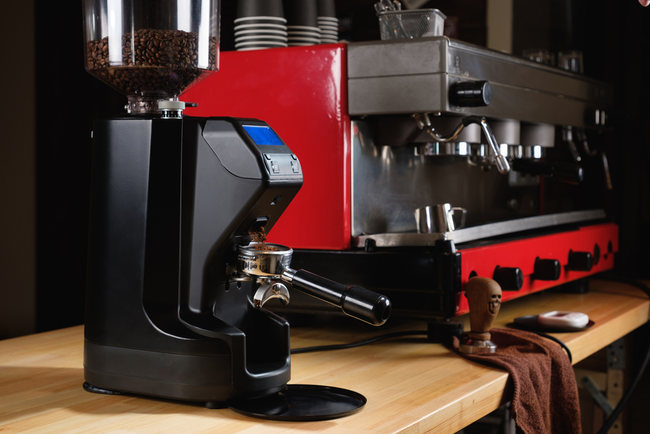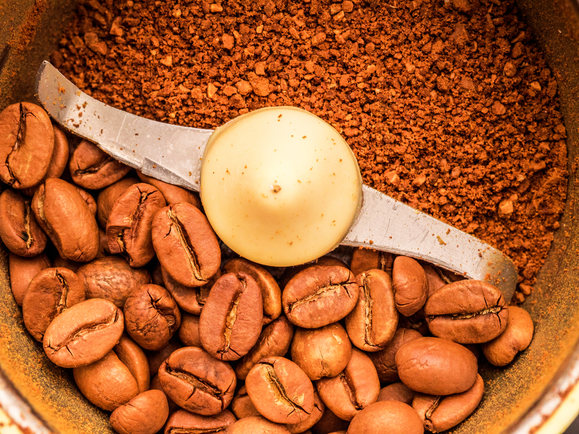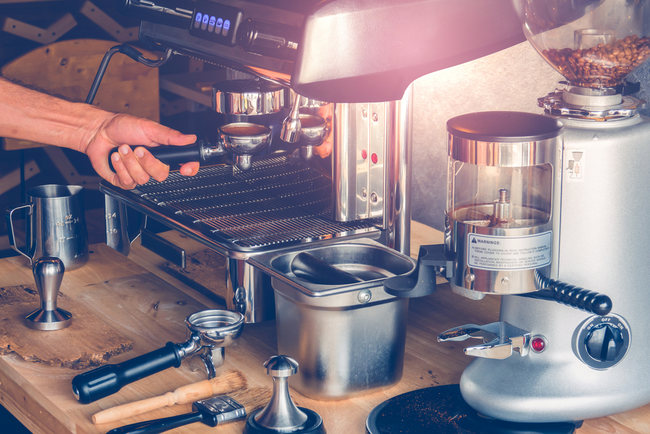Feb 18, 2020

After choosing the right coffee maker that delivers quality for your shop when used, what you cannot do without is a coffee grinder. Coffee grinders come in many forms with different usages. So what kind should you choose so that what you get matches your requirements? How do you buy a coffee grinder so that you don't waste your investment? Makro HoReCa Academy will help you by recommending great coffee machines.
Pick content to read in the article:
- How many different types of coffee grinders are there?
- Types of Coffee Grinders by Blades and Burrs
- What are the differences among ceramic, steel, titanium coated grinding materials?
- How to Choose a Coffee Grinder According to Usage
How many different types of coffee grinders are there?
The main objective of coffee grinding is good coffee flavors. Additionally, each type of coffee maker has to be used with the right level of coarseness/fineness. Effective coffee grinding means making the beans smaller with the right coarseness or fineness.
There are two main types of coffee grinders according to use.
- Hand-crank Coffee Grinder
- This is an old-style coffee grinder. He body is largely made from wood, plastic and steel.
- It is popularly used to make drip, mocha pot and French press coffees, etc.
- It can be carried anywhere because it doesn't use electricity. In addition, the level of coarseness-fineness can be adjusted for different types of fresh coffee making.
- It has a low speed, so there is less heat accumulation in the grinding gears.
- This gives the gears usage durability.

2. Electric Coffee Grinder
2.1 Medium-large electric coffee grinder
- Fast grinding speed and high grinding quantity.
- Adjustable fineness and preparation time.
- Suitable for espresso coffee.
2.2 Small Electric Coffee Grinder
- Few fineness level adjustments.
- Finer results with longer grinding time.
- We recommend for mocha pot and French press coffees.

Types of Coffee Grinders by Blades and Burrs
- Blade grinder
- Commonly found are hand-crank and small electric types.
- You might say that this is more coffee chopping rather than coffee grinding.
- The material used to make most blades is either steel or stainless steel, both of which are suitable for coffee grinding with low levels of fineness, even though the hand-crank type permits fineness adjustments.
- Most blades are dipped in carbon to make them stronger than ordinary steel.
- This type of grinder is inexpensive but not suitable for fresh coffee shops. This is because it produces inconsistent coffee powder and doesn't permit adjustment of fineness (since it relies on grinding time to determine fineness).
- Maintain by avoiding moisture, as that can cause rust. If the blades are not subjected to impacts or scratched, they will be less likely to rust.
- Suitable for making mocha pot, French press, and cold drip coffees. Some even can grind for aero-press and drip/pour over coffees.

2. Burr Grinder
- This type is commonly found in the hand-crank or medium-large electric types.
- French Press An advantage of this type is that it can grind coffee to a high level of fineness. It can grind from the espresso level up to a coarse level like French press.
- Fineness-coarseness levels can be adjusted by a cog at the middle.
- Possible levels include "very wide" > "coarse" > "close" > "fine".
- It is easy to clean. Just space the two grinding burrs apart and then clean by using a brush every time after use.
We recommend a 50-mm-burrs coffee grinder with a powerful 180W motor with 1400RPM speed, 500-g coffee bean capacity and three different types of grinding for 1 cup/2 cups at a time and with 1-year motor warranty. Click to see an actual machine
3. Conical Burr Grinder
- The bottom burr rotates while the top burr adjusts up and down.
- Coffee power produced will be crystalized or with particles more consistently sized than flat burrs.
- Flavors are even with great body and less sourness.
- A disadvantage is that its coarseness is harder to adjust than flat burr.

What are the differences among ceramic, steel, titanium coated grinding materials?
Ceramic
- An advantage is that it is sharp and cuts through coffee beans well while also being slow to heat up.
- It does not conduct electricity.
- It is resistant to heavy use.
Steel
- It has strength and is difficult to corrode.
- It can be made into different shapes while also being flexible.
- It can be mixed with carbon for stronger steel capable of withstanding a high level of corrosion.
Titanium Coated
- The burrs that appear golden in color are metal coated in titanium.
- It is very strong and takes more time to corrode.
- It can withstand a lot of heat.
- It is quite expensive, and only a few brands manufacture them.
So, what kind is better? Ceramic burrs are capable of withstanding heavy use, so they have a longer usage life than steel. However, their disadvantage is that you cannot grind ceramic on ceramic, as doing so would break the teeth, since ceramic is strong but brittle. Accordingly, steel is not necessarily worse. It's just that ceramic grinders are newer.
Now that you know the different types of coffee grinders, we are going to recommend coffee grinders for different uses to ensure correct and appropriate use.
How to Choose a Coffee Grinder According to Usage
- We recommend hand-crank coffee grinders for people who need special time and meticulousness in making coffee while also being skilled in coffee-grinding. Otherwise, the coffee coarseness might be unattractive and the coffee will not taste good.
- We recommend the electric type for speed and convenience. Electric coffee grinders are the solution for people who need coffee-grinding speed, as they can grind large amounts of coffee at the same time.

3. We recommend a grinder with several different of coarseness settings if a high-level of fineness is required. Most coffee shops use large, highly-effective grinders that feature many different grinding functions, primarily for the benefit of grinding speed and maximum retention of the fragrance and freshness of ground coffee beans. jIn addition, high levels of precision yields coffee powder for several different types of coffee.
We recommend a coffee grinder that permits up to 18 different levels of fineness with grinding amounts ranging from 4-18 cups and power at 125 watts and 25,500 RPM speed. The box for holding coffee can hold as many as 32 cups of ground coffee. Click to see an actual machine (link to https://bit.ly/2Snq2i1).
4. Select special fineness for espresso. This is because a rich coffee flavor requires making by compressing coffee powder tightly for extraction and running coffee water through the power in the portafilter, where the ground coffee cannot be left for long. Accordingly, an electric coffee grinder with short grinding time and fineness adjustability should be chosen in order to maintain freshness and flavor in the coffee.
We recommend a coffee grinder capable of finely grinding coffee beans suitably for an espresso machine with a pressurized portafilter. It has 50 mm burrs and has 34 adjustable grinding levels, and the tank can hold 250 grams of coffee beans, while the grinder has a 2-year warranty. Click to see an actual machine
Choose a blade material to retain flavor. Whether you use a hand-crank or electric type, the material of the blades is important, as it significantly contributes to the flavor of the coffee. Generally, most manufacturers prefer to use steel blades, because they are strong, difficult to corrode. However, they accumulate heat, so the steel might leave an odor.
We recommend a large coffee grinder suitable for a large coffee shop. Manufactured in Italy, features silent operation, stainless steel structure, adjustability for every size with standard form, circular-rotation grinding by the rotation of steel blades, and measurable coffee output levels with a sound safety alarm safety system when the machine gets too hot. The machine can adjust coffee grinding numbers ranging from very coarse and very fine with 10.5 kilogram/hour grinding capacity. Click to see an actual machine
